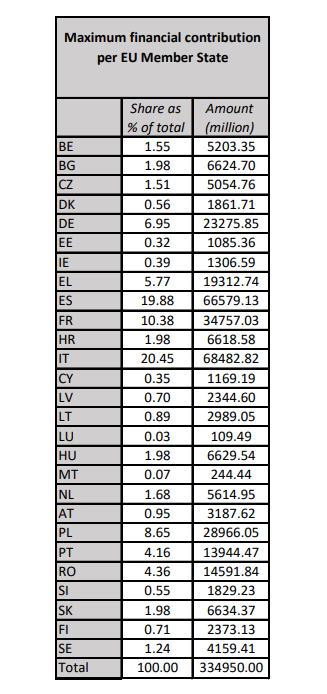So let& #39;s take a walk through the fairly complex construction that is the @EU_Commission& #39;s Recovery Instrument proposal. As a diligent bureaucracy, the Commission has done a good job to slice and dice policy into a myriad of legal acts.
Thread: https://ec.europa.eu/info/strategy/eu-budget/eu-long-term-budget/2021-2027_en">https://ec.europa.eu/info/stra...
Thread: https://ec.europa.eu/info/strategy/eu-budget/eu-long-term-budget/2021-2027_en">https://ec.europa.eu/info/stra...
1/ First, the EU needs a legal basis to get this extraordinary move going. It has found it in Article 122 TFEU. On this basis, there will be a Council Regulation authorising the EU to do 500 bn in additional spending and 250 bn in loans.
Here is the draft: https://ec.europa.eu/info/sites/info/files/about_the_european_commission/eu_budget/com_2020_441_en_act_part1_v13.pdf">https://ec.europa.eu/info/site...
Here is the draft: https://ec.europa.eu/info/sites/info/files/about_the_european_commission/eu_budget/com_2020_441_en_act_part1_v13.pdf">https://ec.europa.eu/info/site...
2/ This Regulation requires qualified majority in the Council. It creates a time-limited vehicle for specific expenditure that is financed exclusively through so-called "externally assigned revenue". This is money that does not come from usual EU budget revenue, but on top.
3/ In this case, the externally assigned revenue comes from borrowing - and this is where the second important legal act comes in: The new Own-Resources Decision (ORD) under Art. 311 TFEU. The draft is still missing, but we can extrapolate the content from what is already public.
4/ It does two things: It authorises the EU to borrow for the specific purpose of the expenditure in the 122 legal act. And it increases the EU& #39;s own resource ceiling to a level that assures markets that the EU will always have the resources to pay back the loans.
5/ So we have a combination: The 122 act is the basis for the exceptional expenditure, the ORD is where the borrowing happens. And because the ORD requires unanimity and ratification by national parliaments, the whole package falls under unanimity.
6/ The fact that the borrowed money is considered externally assigned revenue means that the expenditure financed by it does not show up in the MFF. Hence parliament does not even have to consent here. But it does have a say in the next step.
7/ The 122 legal act is only the general authorisation - specific spending needs to happen through programmes, and these are decided in co-decision by EP and Council. So the EP also needs to be on board for the package.
8/ Most of the additional spending (310 bn in 2018 prices) will happen through the Recovery and Resilience Facility. Countries will have to submit plans with eligible investments or reforms to tap their share (see allocation). The draft Regulation is here: https://ec.europa.eu/info/sites/info/files/com_2020_408_en_act_part1_v9.pdf">https://ec.europa.eu/info/site...
9/ 123 additional billion euros in new EU expenditure is distributed over a number of EU programmes (Just Transition Fund, EU-REACT, EU4Health). About 67 billion are to be leveraged by the EIB.
The legal texts can be found in the link: https://ec.europa.eu/info/publications/mff-2021-2027-sectoral-acts_en">https://ec.europa.eu/info/publ...
The legal texts can be found in the link: https://ec.europa.eu/info/publications/mff-2021-2027-sectoral-acts_en">https://ec.europa.eu/info/publ...
10/ If you count together the country shares in all these programmes, you& #39;ll likely get to the numbers floated yesterday (though we do not know for sure, because the Commission has not published them yet).
11/ So: A building with many pillars leading to the need for agreement by Council, European Parliament and national parliaments. But this is probably the right way to go for this extraordinary step at an extraordinary moment.

 Read on Twitter
Read on Twitter


